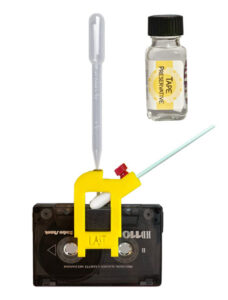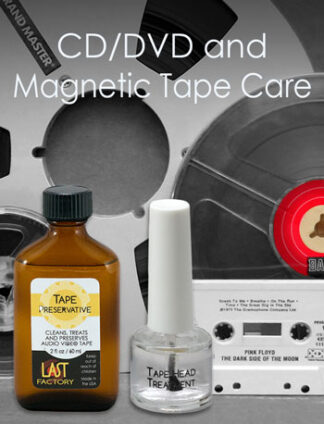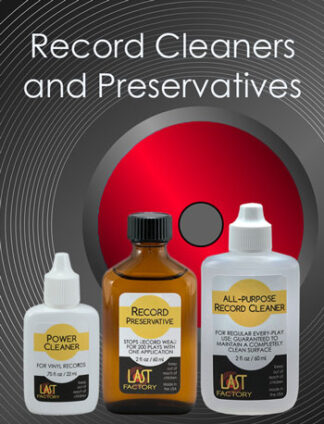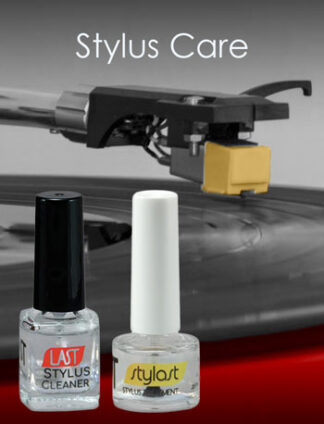I’ve recently discovered that some of the compact cassettes I have dating from the early 1980s will no longer play. The various cassette decks I have tried struggle to advance the tape, either occasionally slowing down or at worst halting altogether. Winding the cassettes forwards or backwards works fine, and I have not found any significant residue left on the playback head when I have cleaned them. However, I have noticed that the surface of the tape appears dull compared to the glossy, shiny appearance of those cassettes that do play. Searching on the Internet lead me o discover LAST Tape Preservative, but is it appropriate for the symptoms I have experienced with my cassettes? If it is, how many C15 cassettes would a 2 oz. bottle typically treat? I appreciate any help and advice you can provide with this matter.
Regards, P. F.
[UPDATE: We probably should have mentioned first that there may also be mechanical reasons for the described behavior. With poor storage or heat or simply poor manufacture, cassettes can be warped or otherwise restrict the motion of the tape. Make sure the tape turns freely by hand before chasing down other issues. FF and Rewind often use different motors or gearings than playback, so the fact that a tape rewinds is not sufficient to say that the motion is unrestricted. -Jeff]
A 2 oz bottle of LAST Tape Preservative should treat between 60 and 65 C15 Cassette tapes.
If you have available a cassette winding device, that would make an excellent spooling machine to move the tape past the applicators. Without that, I would suggest using an old portable cassette player (with the head removed as a spooling machine to accomplish the treatment of your tapes. We now sell a device to apply Tape Preservative to cassette tapes, called the Cassette Hero. It makes application quite easy, once you have a tape winder.
Thank you for your query, Walter Davies
 It is great to know that a 2oz bottle can treat that many cassettes. I have several hundred in my collection and so treating them all would be viable.
It is great to know that a 2oz bottle can treat that many cassettes. I have several hundred in my collection and so treating them all would be viable.Yes, treated cassettes should play successfully in your system. But here are the caveats! The machines’ pinch roller must properly engage the capstan(s) to transfer the tape past the heads and guides. Drying the tape is a big help in eliminating tape squeal, stiction, and stalling.
Without access to a vacuum chamber, we have many tape lovers that store their tapes (all formats) in plastic boxes with tight fitting lids. The bottom of the boxes have a layer of silica gel. Above that is an open mesh screen, above that the tape is stored. Some people seal the boxes with packaging tape to prevent intake of moisture from the atmosphere. Lacking a hard vacuum, the process of moisture removal is determined by the length of time for moisture within the tape pack to diffuse to the surface of the tape, and then move across the surface to the edge of the tape pack. This can take many days, to weeks to accomplish. However, by placing all of your tape into air-tight containers with drying agent, you will already start the process of rejuvenating your tapes – even before you apply the treatment. In the case of cassettes, the diffusion process progresses much more quickly that in R – R and typical video tape formats.
Magnetic media that has been dried and subsequently treated with the preservative is remarkably resilient and can substantially resist the up take of moisture from the air. I do not know of any cassette users that have required re-treatment.
For awhile, there were several firms that advocated “Baking” as the sole answer to problem tapes. The tapes were inclosed in an oven and brought up to a temperture of 135 – 150 degrees F. This process could mobilize moisture and speed up the diffusion process. The “unintended” consequence of this process was loss of plasticiser from the tape and matrix (in which the magnetic particles are suspended). This created a condition called “Gel Blocking” in which cooling that was too quick, shrunk the tape pack from the outside in and welded the inner third to half of the tape pack together. BAD NEWS and some Very unhappy collectors.
Though wordy, I hope that this will help your store of information.
All the Best, Walter





